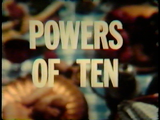
A muon is an elementary particle similar to the electron, with an electric charge of −1 e and a spin of 1/2, but with a much greater mass. It is classified as a lepton. As with other leptons, the muon is not thought to be composed of any simpler particles; that is, it is a fundamental particle.
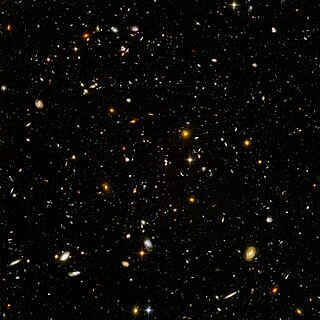
The universe is all of space and time and their contents. It comprises all of existence, any fundamental interaction, physical process and physical constant, and therefore all forms of energy and matter, and the structures they form, from sub-atomic particles to entire galaxies. Space and time, according to the prevailing cosmological theory of the Big Bang, emerged together 13.787±0.020 billion years ago, and the universe has been expanding ever since. Today the universe has expanded into an age and size that is physically only in parts observable as the observable universe, which is approximately 93 billion light-years in diameter at the present day, while the spatial size, if any, of the entire universe is unknown.

The cosmos is an alternative name for the universe or its nature or order. Usage of the word cosmos implies viewing the universe as a complex and orderly system or entity. The cosmos, and understandings of the reasons for its existence and significance, are studied in cosmology – a broad discipline covering scientific, religious or philosophical aspects of the cosmos and its nature. Religious and philosophical approaches may include the cosmos among spiritual entities or other matters deemed to exist outside the physical universe.

IMAX is a proprietary system of high-resolution cameras, film formats, film projectors, and theaters known for having very large screens with a tall aspect ratio and steep stadium seating, with the 1.43:1 ratio format being available only in few selected locations.
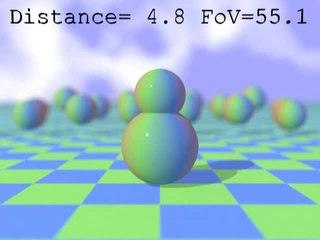
A dolly zoom is an in-camera effect that appears to undermine normal visual perception.
The Atom is a name shared by five superheroes appearing in American comic books published by DC Comics.

A power of 10 is any of the integer powers of the number ten; in other words, ten multiplied by itself a certain number of times. By definition, the number one is a power of ten. The first few non-negative powers of ten are:

Albert Rothstein is a superhero appearing in American comic books published by DC Comics. Atom Smasher is known for his power of growth and super strength.

Philip Morrison was a professor of physics at the Massachusetts Institute of Technology (MIT). He is known for his work on the Manhattan Project during World War II, and for his later work in quantum physics, nuclear physics high energy astrophysics, and SETI.
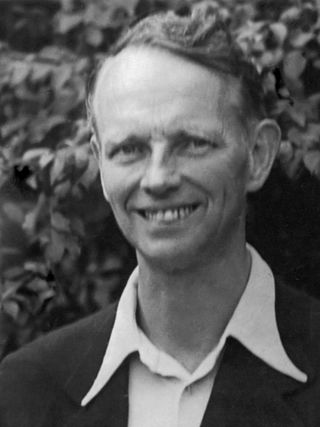
Cornelis "Kees" Boeke was a Dutch reformist educator, Quaker missionary and pacifist. He is best known for his popular essay/book Cosmic View (1957) which presents a seminal view of the universe, from the galactic to the microscopic scale, and which inspired several films.
Cosmic View: The Universe in 40 Jumps is a 1957 book by Dutch educator Kees Boeke that combines writing and graphics to explore many levels of size and structure, from the astronomically vast to the atomically tiny. The book begins with a photograph of a Dutch girl sitting outside a school and holding a cat. The text backs up from the original photo, with graphics that include more and more of the vast reaches of space in which the girl is located. It then narrows in on the original picture, with graphics that show ever smaller areas until the nucleus of a sodium atom is reached. Boeke writes commentary on each graphic, along with introductory and concluding notes.
This timeline lists significant discoveries in physics and the laws of nature, including experimental discoveries, theoretical proposals that were confirmed experimentally, and theories that have significantly influenced current thinking in modern physics. Such discoveries are often a multi-step, multi-person process. Multiple discovery sometimes occurs when multiple research groups discover the same phenomenon at about the same time, and scientific priority is often disputed. The listings below include some of the most significant people and ideas by date of publication or experiment.

Cosmic Voyage is a 1996 short documentary film produced in the IMAX format, directed by Bayley Silleck, produced by Jeffrey Marvin, and narrated by Morgan Freeman. The film was presented by the Smithsonian Institution's National Air and Space Museum, and played in IMAX theaters worldwide. The film is available in the DVD format.
Cosmic Zoom is a 1968 short film directed by Robert Verrall and produced by the National Film Board of Canada. It depicts the relative size of everything in the universe in an 8-minute sequence using animation and animation camera shots.
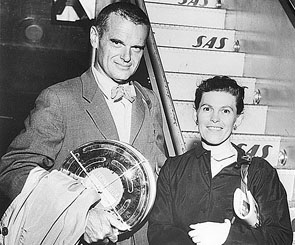
Charles Eames and Ray Eames were an American married couple of industrial designers who made significant historical contributions to the development of modern architecture and furniture through the work of the Eames Office. They also worked in the fields of industrial and graphic design, fine art, and film. Charles was the public face of the Eames Office, but Ray and Charles worked together as creative partners and employed a diverse creative staff. Among their most recognized designs is the Eames Lounge Chair and the Eames Dining Chair.

In classical physics and general chemistry, matter is any substance that has mass and takes up space by having volume. All everyday objects that can be touched are ultimately composed of atoms, which are made up of interacting subatomic particles, and in everyday as well as scientific usage, matter generally includes atoms and anything made up of them, and any particles that act as if they have both rest mass and volume. However it does not include massless particles such as photons, or other energy phenomena or waves such as light or heat. Matter exists in various states. These include classical everyday phases such as solid, liquid, and gas – for example water exists as ice, liquid water, and gaseous steam – but other states are possible, including plasma, Bose–Einstein condensates, fermionic condensates, and quark–gluon plasma.

Blue Planet is a 1990 IMAX film directed by Ben Burtt, and produced by the IMAX Space Technology corporation for the Smithsonian Institution's National Air and Space Museum, as well as Lockheed Corporation. Filmed with the cooperation of the NASA, it was written, edited, and narrated by Toni Myers.
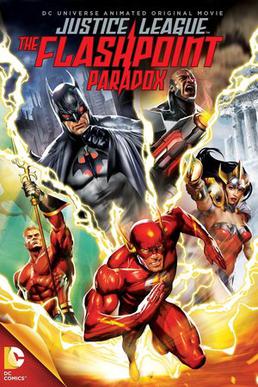
Justice League: The Flashpoint Paradox is a 2013 direct-to-video animated superhero film directed by Jay Oliva and written by Jim Krieg. It is the adaptation of the 2011 comic book crossover "Flashpoint" by Geoff Johns and Andy Kubert. The film stars Justin Chambers as Barry Allen / Flash, C. Thomas Howell as Eobard Thawne / Professor Zoom, Michael B. Jordan as Victor Stone / Cyborg, Kevin McKidd as Thomas Wayne / Batman and Cary Elwes as Orin / Arthur Curry / Aquaman. The film also sees actors reprising roles from other DC animated series, including Kevin Conroy as Bruce Wayne / Batman, Nathan Fillion as Hal Jordan / Green Lantern, Ron Perlman as Slade Wilson / Deathstroke, Dana Delany as Lois Lane, Vanessa Marshall as Princess Diana / Wonder Woman and Dee Bradley Baker as Etrigan.
Cosmic Eye is a short 2012/2018 film and iOS app, developed by astrophysicist Danail Obreschkow. It shows the largest and smallest well known scales of the universe by gradually zooming out from and then back into the face of a woman called "Louise". According to the developer, the film and app were inspired by the essay Cosmic View (1957) and the short films Cosmic Zoom (1968) and Powers of Ten (1977), but uses state-of-the-art technology and new scientific imaging and computer simulations. Cosmic Eye, although developed in 2012 for local teaching and outreach purposes, in April 2016 it suddenly attracted 40 million views in just ten days on the Facebook group page of "The Science Scoop". The video has since been viewed more than 200 million times on Facebook and was featured in major media, such as BBC World News.
The Scientific American Library is a book series of popular science written by scientists known for their popular writings and originally published by Scientific American books from 1983 to 1997. These books were not sold in retail stores, but as a Book of the Month Club selection priced from $24.95 to $32.95.
